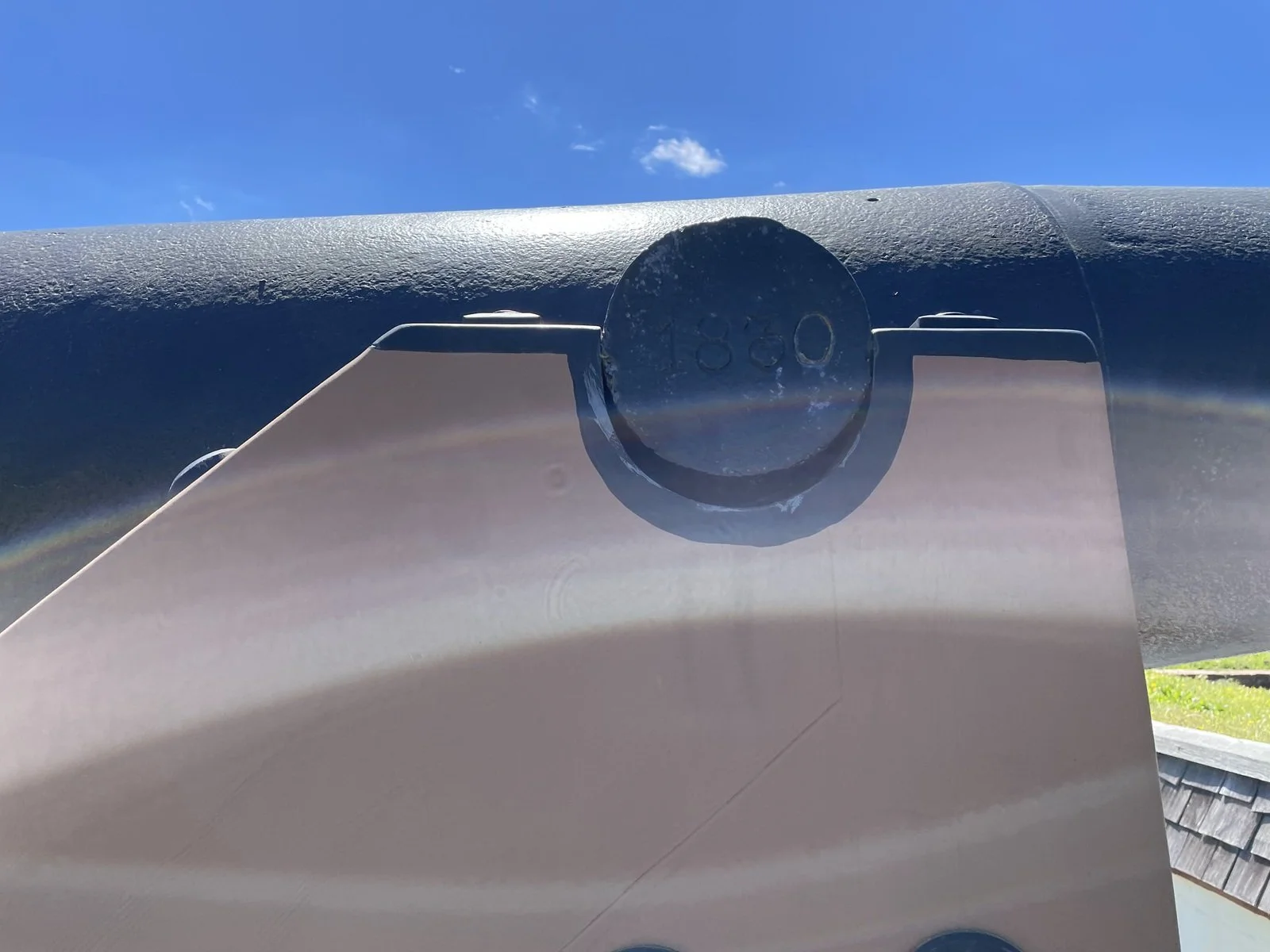Cannons of Fort Moultrie
Two Model 1829 32-Pounders preserved at Fort Moultrie. The two cannon are mounted on front-pintle barbette carriages. The steeple of Stella Maris Catholic Church may be seen in the background.
32-Pounder Model 1829 - Note the circular test scar on the left trunnion.
On June 28th, 1776, Fort Sullivan, built primarily of palmetto logs and sand, armed with an assortment of cannon the heaviest of which were French 24-Pounders, and under the command of Colonel William Moultrie, repulsed the attack of the Royal Navy squadron of nine ships commanded by Commodore Peter Parker.
From the time of the American Revolution until the end of the Second World War, this fortification, renamed Fort Moultrie to honor it’s first commander, anchored Charleston’s seacoast defenses.
While I’ve previously covered much of Fort Moultrie’s heavier ordnance, the fort also displays two US Army Model 1829 32-Pounders and one US Army Model 1819 24-Pounder. These cannon illustrate the types in service after the Fort was rebuilt in brick in 1808-1809. While replaced where possible by larger types during the war, 32-Pounders and 24-Pounders were used to arm secondary defenses, particularly in the South.
The two 32-Pounders were both cast by the Bellona Foundry in Richmond, Virginia in 1830. They are registry number 124 and 163. The 24-Pounder was cast by the West Point Foundry in 1838. The 32-Pounders, despite being produced for the US Army, have loops for naval breeching ropes above the cascabels. None of the three cannon is likely to have seen war-time service at Fort Moultrie. The 32-Pounders had previously been at the Yorktown National Cemetery in Virginia. The 24-Pounder had been sent to Vicksburg in 1933 from the Watervliet Arsenal in New York - eventually being traded to Fort Moultrie for another cannon. The Civil War service of the three cannons is unknown, though, again, they are of types used during the war.
24-Pounder Model 1819 - Note the testing scar upon the muzzle.
The 24-Pounder bears a fascinating scar upon its muzzle. As Mike Ryan writes in “The Historic Guns of Forts Sumter and Moultrie” (the excellent source for much of this post), this scar shows were metal was removed from the tube following the 1844 bursting of the “Peacemaker” aboard USS Princeton. Following this and other notable cannon failures, a testing program was instituted. Metal was removed from the cannon to test its strength. (The circular holes in the left trunnions of the two 32-Pounders were made for similar purpose.)
Also on display in the Visitors Center at Fort Moultrie is a 17th Century British 12-Pounder bearing the “Broad Arrow.” This cannon was discovered in Jacksonville, Florida and was sent to Fort Moultrie to represent the “whatever was available” armament of the 1776 Fort Sullivan. On the ground between the Fort and the Atlantic is an unmounted cannon. This tube is of modern origin. I remember four such cannon being mounted on naval carriages in the 1990s, and I believe they were made for a reconstruction of the palmetto fortification that was built at the time of the 1976 Bicentennial Celebrations.
17th Century British 12-Pounder
The sign describing the origin of the British 12-Pounder cannon - and showing an image of the 1970s reconstructed battery.
Fort Moultrie is very well interpreted to show the history and progression of American Seacoast Defense from 1776 to 1945. If you are in the Charleston area, it is well worth a visit. And as we approach June 28th, may I go ahead and wish you a Happy Carolina Day!
Repro Cannon which was part of the 1970s Fort Sullivan Reconstructed Battery
View of the interior of Fort Moultrie from the WWII-era Observation Tower. At left you can see the two 15-Inch Rodmans. A 10-Inch Columbiad mounted on a blue carriage can be seen just to the left of the flagpole. One of the two 32-Pounders can be seen at right (the tube of the other is just visible above the roof of the magazine). The 24-Pounder can be seen near the base of the flag pole.
“26 Pound Cannonball” - The heaviest cannon of Fort Sullivan where 19 French 24-Pounders which had been taken off the French ship-of-the-line Foudroyant which had been captured by the British in 1758. They are referred to as 26-pounders due to the French pound being a bit heavier than the English. I find it interesting that the British Crown armed a colony with these non-standard cannons.
May I advise my fellow amateur cannon photographer to look where one is going while walking at Fort Moultrie lest one fall into the gaping chasm between the barbette and the magazine? Not at all something that nearly happened to me…
This solid brick traverse at Fort Moultrie protects the entrance to the magazine from seaward fire.
The interior of the magazine.
Fort Sullivan Flag as displayed at the Powder Magazine in Charleston. The modern South Carolina flag commemorates the Battle of Fort Sullivan with the Palmetto Tree and the Gorget (or cresent moon) from the Fort Sullivan Flag.
Additional Views from Fort Moultrie

















